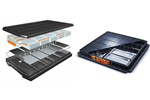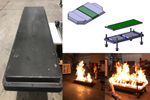Kautex wins first order for Pentatonic fiber-reinforced skid plate catering to BEVs
Automotive OEM order marks Kautex’s entrance into thermoplastic composite and composite-metal hybrid battery housings and related components.
Pentatonic battery system. Photo Credit: Kautex Textron GmbH & Co. KG
(Kautex, Bonn, Germany), a Textron Inc. company that designs and manufactures thermoplastic composite and composite-metal hybrid automotive battery systems, announced it has received the first order from an automotive OEM for a fiber-reinforced thermoplastic composite underbody battery protection skid plate. The skid plate is part of the company’s new Pentatonic battery system product line supporting battery electric vehicle (BEV) production.
Pentatonic is a lightweight, customizable solution produced from a fiber-reinforced thermoplastic or composite-metal hybrid. The new skid plate design will be produced for on-and-off-road applications, Kautex says. It is designed to meet impact requirements and features more than a 50% weight reduction versus its steel counterpart. According to the company, Pentatonic’s material composition and production processes also offer inherent corrosion resistance, design flexibility, improved serviceability and overall higher value than other alternatives.
“Research, development and testing has proven our system offers improved performance versus steel and aluminum systems while reducing weight and CO2 emissions and simplifying the production process,” Felix Haas, director, Pentatonic product development, notes. “Our customer understands the system-level benefits we offer and is leading the industry in the transition to composite-based structures to meet their needs.”
The Pentatonic system recently won the Enabler Technology Award from the Internationale Gesellschaft für Kunststofftechnik, SPE Central Europe for its Pentatonic battery system and a Langxuan Innovation Award in China. Additionally, last fall, the system underwent rigorous testing in accordance with internationally recognized standards including the Chinese GB 38031 standard and the ECR R100 from the Economic Commission for Europe (ECE). The system successfully met the requirements for numerous tests including mechanical shock, crush, drop, vibration and bottom impact testing.
See “Composites end markets: Batteries and fuel cells (2023)” for more information about composites use in electric vehicle/BEV applications.
Related Content
-
Thermoplastic composites: Cracking the horizontal body panel nut
Versatile sandwich panel technology solves decades-long exterior automotive challenge.
-
Braided thermoplastic composite H2 tanks with co-consolidated molded boss areas to fit EV battery space
BRYSON project demonstrates possible designs, automated manufacturing and low permeability concepts, including EVOH liner and novel PPA matrix.
-
Plant tour: Sekisui Aerospace, Orange City, Iowa, Renton and Sumner, Wash., U.S.
Veteran composites sites use kaizen and innovation culture to expand thermoplastic serial production, 4.0 digitization and new technology for diversified new markets.






